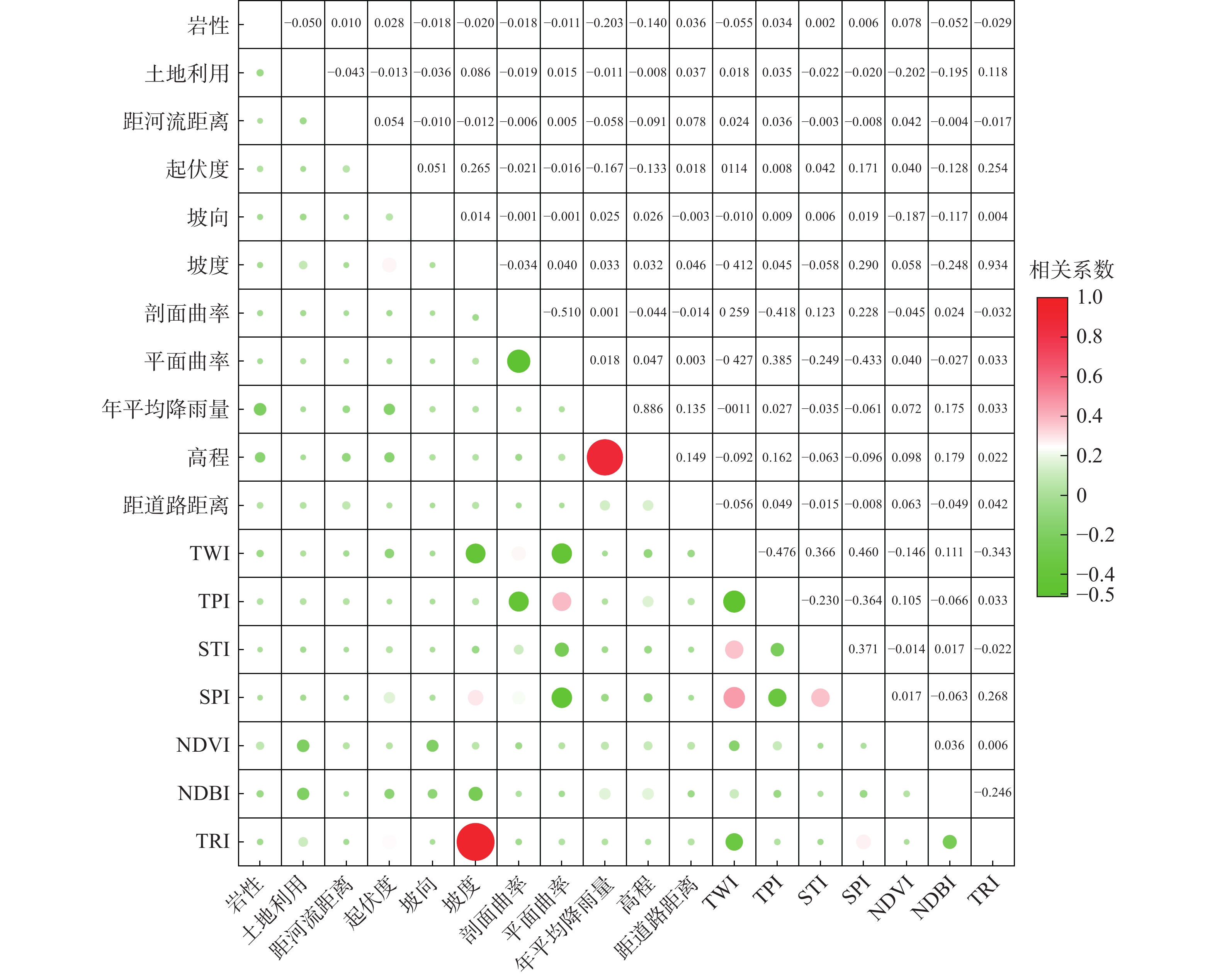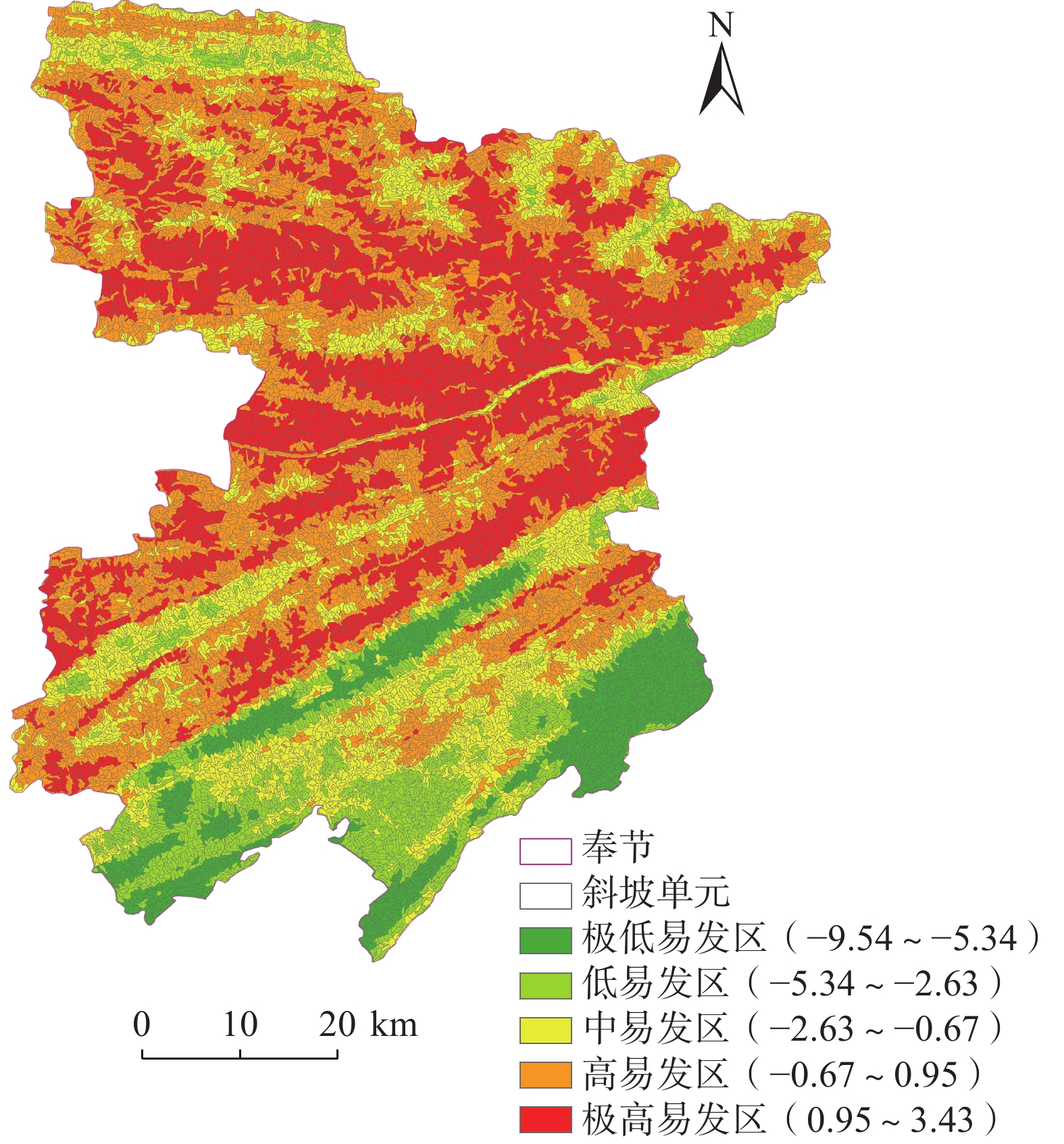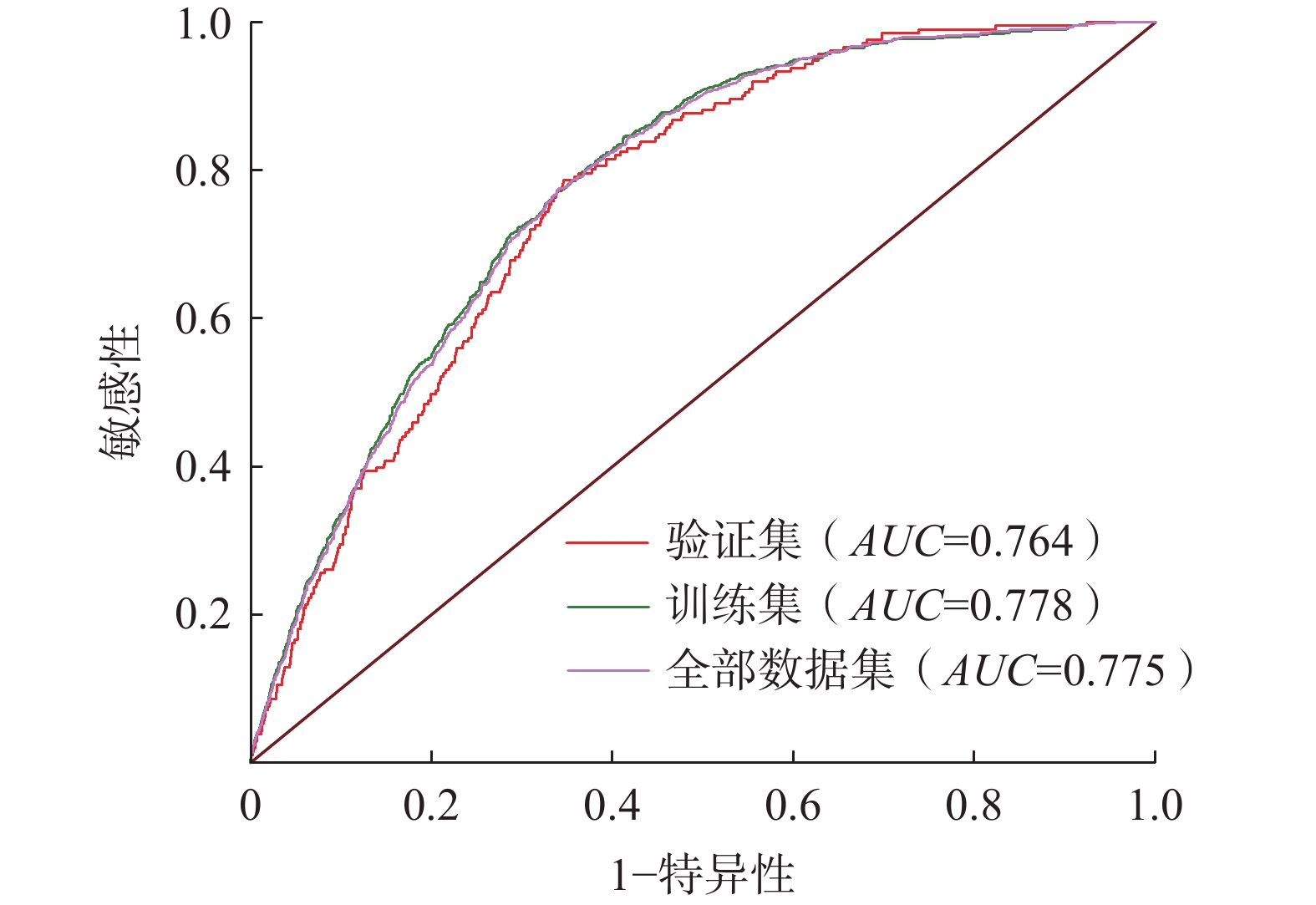Landslide susceptibility evaluation in Fengjie County based on slope units extracted using the MIA-HSU method
-
摘要:
栅格单元难以表征斜坡的形态与边界,以其为制图单元的滑坡易发性评价结果无法精细化描述自然斜坡的滑坡易发程度。而形态图像分析-均匀坡度单元(morphological image analysis-homogeneous slope unit,MIA-HSU)方法提取的斜坡单元可以表征斜坡的形态与边界,并能克服传统方法提取的斜坡单元存在坡度突变的缺陷。文章使用MIA-HSU为滑坡易发性评价提供制图单元。以重庆市奉节县为研究区,选取高程、坡度、坡向、归一化植被指数、归一化建筑指数、起伏度、距河流距离、距道路距离、岩性、剖面曲率、土地利用、地形湿度指数、水流功率指数、泥沙输移指数、地形位置指数等15个指标,采用信息量法评价奉节县的滑坡易发性程度。评价结果表明,滑坡易发性越高的区域灾害点密度越大,1950—2015年参加训练的滑坡点落在极高易发区和高易发区中的比例为 94.13%,成功率曲线法对滑坡易发性评价结果的测试精度为0.764,表明评价结果与实际滑坡分布情况基本吻合;2018年以后发生的未参与模型训练的滑坡点中超过90%落在高易发区和极高易发区,说明易发性评价结果具有较高的泛化性。研究结果可为研究区滑坡隐患点识别和灾害防治提供科学参考。
Abstract:Grid units have limitations in accurately delineating the morphology and boundaries of slopes, and when used as mapping units in landslide susceptibility evaluation, they cannot accurately describe the landslide susceptibility of natural slopes. Investigations have shown that the morphological image analysis-homogeneous slope unit(MIA-HSU) method provides slope units that are more homogenous in slope angle and aspect, addressing the deficiencies of traditional methods. In this study, MIA-HSU was applied to provide mapping units for landslide susceptibility evaluation. Taking Fengjie County, Chongqing as the study area, 15 factors including elevation, slope angle, slope aspect, normalized difference vegetation index (NDVI), normalized difference built-up index(NDBI), topographic relief, distance from rivers, distance from roads, lithology, profile curvature, land use, topographic wetness index (TWI), stream power index (SPI), sediment transport index (STI), and topographic position index(TPI) were selected to evaluate landslide susceptibility using the information value method. The evaluation results indicated that areas with higher landslide susceptibility exhibited a greater density of disaster points. During the 1950 to 2015 period, 94.13% of the landslide points used for training fell within the extremely high and high susceptibility zones. The accuracy of landslide susceptibility evaluation was further verified using the success rate curve method. The accuracy of the verification set was 0.764, indicating that the evaluation results were generally consistent with the actual landslide distribution. Over 90% of the landslide points occurring after 2018 (which were not used in training) were located in the high and extremely high susceptibility zones, demonstrating the model’s high generalization ability. The findings provide a scientific basis for identifying potential landslide hazards and for landslide prevention and mitigation in the study area.
-
Keywords:
- landslide /
- slope unit /
- information value method /
- susceptibility evaluation /
- MIA-HSU method
-
0. 引言
地质环境质量是判定和评价一个区域地质环境总体条件和建设适宜性好坏的指标,能够为区域地质环境规划和地质环境问题的治理提供决策支持[1-2]。层次分析法是一种多要素综合评价方法,在地质环境质量评价中发挥着重要作用[3-5],其中评价指标体系的建立是利用层次分析法评价地质环境质量的关键。目前的研究多是利用一套评价指标体系对包含多种地貌类型的区域开展地质环境质量评价[6-7],而不同地貌类型的地质环境影响因子有所不同,因此导致地质环境质量评价结果在不同的地貌类型间有较明显的差异,评价结果不能有效体现研究区域不同地貌类型的地质环境质量特征。
针对上述问题,本研究以北京地区为例,根据北京地区地质环境特点,采用层次分析法建立基于不同地貌类型的地质环境质量评价体系,分别对山区和平原区开展地质环境质量评价。评价结果与基于单一评价体系的评价结果进行比较,探索更加合理的地质环境质量评价指标体系,有利于北京市地质环境的总体保护与防治。
1. 研究区地质环境概况
北京市位于东经115°25′~117°30′,北纬39°28′~41°05′,地处华北平原北部,总体地势西北高、东南低(图1)。西北部为太行山脉和燕山山脉交汇形成的中低山地貌,东南部为各大水系冲洪积形成的平原地貌,其中山区面积广泛,占总面积的62%。
北京地区存在的主要地质环境问题分为山区和平原区两部分。在山区主要表现为矿山开发导致的环境破坏,突发地质灾害隐患分布广泛。北京市各类矿点共计386处,矿山占地面积100.59 km2,虽然绝大多数矿点已关停,但是以往的矿业活动仍严重影响着当地的地质环境。另一方面,北京市突发地质灾害较为发育,有数量多、分布广、种类多的特点;目前北京市各类地质灾害隐患点达5037处,主要分布在北部和西部山区的10个郊区县内,隐患数量以密云区、房山区、怀柔区居多,地质灾害隐患种类包括崩塌、滑坡、不稳定斜坡、泥石流和地面塌陷5种类型。
在平原区主要为活动断裂引起的地表位移和失稳,以及地下水过度开采导致的地面沉降。北京平原区活动断裂主要包括:南口孙河断裂带、高丽营断裂带和夏垫断裂带,其中高丽营断裂带在高丽营附近断裂面直达地表,近地表断距1.58 m[8]。截至2014年,北京平原区共发育7个地面沉降中心,主要分布在朝阳区、昌平区、顺义区、大兴区和通州区,最大累积沉降量(1955—2014年)1585 mm,历史最大沉降速率达:159.6 mm/a。
2. 研究方法
本研究的总体思路是,针对北京市山区和平原区的地质环境特点,分别建立两套不同地貌类型下的评价指标体系开展地质环境质量评价。具体方法是,将研究区域划分为一系列独立的评价单元,采用层次分析法对每一个评价单元进行地质环境质量要素的评价,形成评价单元的属性数据库,通过空间分析技术生成北京市全域地质环境质量综合评价结果。
层次分析法AHP(Analytic Hierarchy Process)是一种定性分析和定量分析相结合的决策分析方法[9-10],通过构建地质环境质量评价指标体系层次结构模型及其重要性判断矩阵,获取各评价指标的权重值[11-13],运用综合指数法[14]建立研究区地质环境质量评价综合指数计算模型,开展区域地质环境质量综合评价模型公式:
式中:
3. 地质环境质量评价
3.1 数据获取
本研究全面收集了近五年与北京市地质环境相关的数据资料。主要分为属性数据和空间数据两类。其中属性数据主要包括地质灾害资料、社会人口资料、矿业生产资料等;空间数据主要包括区域地质资料、遥感影像资料、DEM高程数据、水文地质资料等。
3.2 指标体系的建立
评价地质环境质量涉及的因素主要有区域地质环境背景、地质条件的稳定性、地质环境问题及人类工程活动等诸多因素,但影响地质环境质量的优劣是相对的,目前尚无统一的标准去衡量和描述地质环境质量的好坏[15]。选择对评价目标起主导作用、比较稳定、可量化的参评指标,构建合理的评价指标体系是地质环境质量评价工作的关键[16]。
本次地质环境质量指标的选取在参考《区域水文地质工程地质环境地质综合勘查规范》和《生态环境质量评价技术规定》等相关规范[17-18]的同时,结合研究区地质环境现状和存在的地质环境问题,遵循科学性、系统性、独立性和方便性的地质环境质量评价指标体系构建的基本原则,筛选出了13个评价指标,分别构建了北京市山区和平原区三层次的地质环境质量评价指标体系(图2、图3)。第一层为目标层,即北京市地质环境质量;第二层为准则层,包括地质条件、资源环境和人类活动3个评价准则;第三层为指标层,即每个准则所包含的具体的评价指标(表1)。
表 1 评价指标及其含义Table 1. Evaluation indexes序号 评价指标 含义 1 地表高程/m 地表海拔高度,影响地质环境的基础因素之一,它控制着水文、植被、人类活动等因素。 2 地形坡度/(°) 反映地形起伏的地形定量指标,水土流失、地质灾害、水资源等都与坡度有很大的关系。 3 岩土类型 人类生存的最基本的物质条件,评判依据是人类对岩土体的适应性,一般而言,岩性越软,人类的适应性越强。 4 地震烈度 地震时某一地区的地面和各类建筑物遭受到一次地震影响的强弱程度,表征地壳稳定性的重要因素。 5 活动断裂距离/m 某一地区活动断裂对人类活动建设存在的影响程度,用与活动断裂的距离表征。 6 灾害密度/(个·km−2) 对地区地质灾害严重程度的表征,用每平方公里地质灾害的数量表示。 7 地面沉降量/mm 地面沉降是影响人类工程活动建设的重要因素之一,用累积沉降量表示。 8 植被指数 某一地区的植被覆盖程度,用NDVI指数表征,植被是影响区域地质环境质量的重要因素之一。 9 水体面积指数 某地区地表水资源量,用水体面积指数表征,一般情况下,地表水资源量越大,对环境质量的有益贡献就越大。 10 土壤质量 指土壤在一定生态系统内支持生物的生产能力,净化环境能力,促进动植物及人类健康的能力,用土壤质量等级表征。 11 地下水质量 地下水资源的质量状况,用地下水污染的程度表征,如未受污染、轻微污染、严重污染。 12 人口密度/(人·km−2) 单位面积内的人口数量,人口是制约地区经济发展的主要因素,人口密度越大,其地质环境质量也会越差。 13 矿山密度/(个·km−2) 单位面积内的矿点数量,采矿活动严重影响着当地的地质环境质量。 3.3 指标量化分级
不同的指标数据具有不同的单位与量纲,无法直接进行比较和运算,因此必须对数据进行标准量化处理,形成数据形式统一的属性数据库,以便进行指标间的综合运算。地质环境在区域上的差异性决定了评价指标的选取和量化分级具有很强的区域特征,因此量化分级过程必须充分考虑研究区地质环境的实际情况。本研究通过现场调查和专家咨询,同时结合相关规范[19-20],将各评价指标就地质环境质量分为良好、较好、一般3个级别,分别赋值为3分、2分、1分(表2),分值越大对应的地质环境质量越好。
表 2 评价指标量化分级标准Table 2. Grading quantitative standard of geological environment quality indexes影响要素 评价指标 质量状态评分(山区) 质量状态评分(平原区) 良好(3分) 较好(2分) 一般(1分) 良好(3分) 较好(2分) 一般(1分) 地质条件 地表高程/m < 500 500~1000 > 1000 – – – 地形坡度/(°) < 5° 5°~25° > 25° – – – 岩土类型 软岩/松散土 中硬岩 坚硬岩 – – – 灾害密度(个·km−2) 0 1 > 1 – – – 地震烈度/度 < VII VII > VII < VII VII > VII 活动断裂距离/m – – – > 3000 3000~200 < 200 地面沉降量/mm – – – < 500 500~1500 > 1500 资源环境 植被指数 > 0.7 0.7~0.5 < 0.5 > 0.6 0.6~0.3 < 0.3 水体面积指数 1.0~0.5 0.5~0.1 < 0.1 1.0~0.3 0.3~0.05 < 0.05 土壤质量 – – – 优质、良好 好 中等 地下水质量 – – – 未污染 轻污染/中污染 严重污染 人类活动 人口密度/(人·km−2) < 550 550~1500 > 1500 < 1000 1000~7000 > 7000 矿山密度/(个·km−2) 0 1 > 1 0 1 > 1 将收集到的指标数据进行矢量化,并对各评价因子数据进行了1 km×1 km的重采样,即设定综合评价的基本单元大小为1 km2。根据评价指标分级量化标准,对重采样后的指标数据进行量化分级,获得每个评价指标的量化分级图,如图4所示(限于篇幅,仅列部分典型指标)。
3.4 指标权重
采用层次分析法确定各评价指标的权重。经过专家咨询,构建各层级评价要素的重要性判断矩阵,经一致性检验,各层级判断矩阵均能达到满意的一致性,此处不一一列出。根据层次单排序法获得北京市山区和平原区各评价指标的权重(表3、表4)。
表 3 山区地质环境质量评价指标权重Table 3. Geological environment quality evaluation index weight in mountain一级因子 权重 评价指标 总权重 地质条件 0.5499 地表高程/m 0.0687 地形坡度/(°) 0.1520 岩土类型 0.0962 地震烈度/度 0.0469 灾害密度(个·km−2) 0.1862 资源环境 0.2098 植被指数 0.0699 水体面积指数 0.1399 人类活动 0.2402 人口密度/(人·km−2) 0.0601 矿山密度/(个·km−2) 0.1802 表 4 平原区地质环境质量评价指标权重Table 4. Geological environment quality evaluation index weight in plain一级因子 权重 评价指标 总权重 地质条件 0.4434 活动断裂距离/m 0.1774 地震烈度/(°) 0.0887 地面沉降量/mm 0.1774 资源环境 0.3874 植被指数 0.0655 水体面积指数 0.0793 土壤质量 0.1311 地下水质量 0.1115 人类活动 0.1692 人口密度/(人·km−2) 0.0423 矿山密度/(个·km−2) 0.1269 3.5 评价结果
各评价指标的权重值确定后,利用综合指数法模型公式,获得北京山区和平原区地质环境质量评价综合指数计算模型,通过空间分析技术获得各单元的地质环境质量综合评价结果(图5)。利用自然断点法,分别对北京山区和平原区地质环境质量指数进行等级区划,总体上将北京地区地质环境质量划分为3个区:地质环境良好区、地质环境较好区和地质环境一般区(图6-a)。
4. 讨论
利用上述方法和指标因子建立针对北京市全域的单一地质环境质量评价指标体系(图7),通过层次分析和专家评判确定指标权重,利用综合指数法开展北京市全域地质环境质量评价,评价结果(图6-b)与基于地貌的多重评价指标体系评价结果(图6-a)进行比较。
在单一评价指标体系的评价结果中,山区大部为地质环境一般区,山前丘陵-平原地带地质环境良好区,中部平原区为地质环境较好区,地质环境质量区划显示出了明显的地貌特征,地质环境质量评价结果的分带性较为明显,空间分异性较差。在多重评价指标体系的评价结果中,地质环境质量的空间分异性明显得到了增强,山区地质环境良好区和较好区的范围明显增大,地质环境质量的空间分布体现了多种指标因素的影响;平原区活动断裂、地面沉降两大因素的影响得到增强,地质环境一般区的面积明显扩大,地质环境良好区也不局限于山前丘陵-平原,综合体现了土壤质量、地下水质量等因素的影响。
分析上述结果,在参与地质环境质量评价的指标因素中,部分指标受地貌影响具有空间上的局限性,不能代表北京全域的特征,如灾害密度、地形坡度、矿山密度等指标偏重于影响山区地质环境,而活动断裂、地面沉降则只存在于平原区。这些受地貌影响明显的指标因子在同一评价指标体系中被赋予权重值,降低了其对某个地貌类型的影响程度,因此导致地质环境质量评价结果在不同的地貌类型间有较明显的差异,评价结果不能有效体现研究区域不同地貌类型的地质环境质量特征,地质环境质量评价结果的合理性和准确性较差。
5. 结论
不同的地貌类型影响地质环境质量的因素有所不同。在区域地质环境质量评价中,相比于单一评价指标体系,建立基于地貌类型的多重评价指标体系,评价结果能够更加合理、准确地反映研究区的地质环境质量及空间分布状况。
-
表 1 数据源
Table 1 Date sources
数据名称 数据
类型数据
分辨率数据来源 GDEM V3 栅格 30 m 地理空间数据云 土地利用 栅格 30 m 全国地理信息资源目录服务系统 1960—2021年
平均降雨量栅格 1 km 资源环境科学与数据中心 1∶25万道路图 矢量 全国地理信息资源目录服务系统 NDVI/NDBI 栅格 30 m 地理空间数据云, Landsat-8 1∶25万岩性 矢量 地理空间数据云 表 2 各因子图层分类情况及其对应的信息量值
Table 2 Classification and corresponding information values of each factor layer
评价因子 各因子图层各类别对应值 信息增益 高程 分类范围 61~382 382~613 613~816 816~ 1006 1006 ~1204 1204 ~1423 1423 ~1694 1694 ~2123 0.0318 信息量 0.5766 0.5850 0.4827 0.1558 − 0.3198 − 1.5944 − 2.2642 − 3.9106 坡度 分类范围 0~9 9~15 15~20 20~25 25~31 31~38 38~46 46~76 0.0033 信息量 − 0.0344 0.2191 0.2352 0.0776 − 0.1427 − 0.3473 − 0.4424 − 0.6035 坡向 分类范围 平面 北 东北 东 东南 南 西南 西 西北 0.0014 信息量 − 0.1360 − 0.0340 − 0.0273 − 0.0882 − 0.0429 0.1840 0.2527 − 0.0528 − 0.2337 NDVI 分类范围 <−0.12 −0.12~0.12 0.12~0.26 0.26~0.37 0.37~0.47 0.47~0.55 0.55~0.63 >0.63 0.0004 信息量 0.0866 − 0.4897 − 0.0491 − 0.0943 0.0181 0.0870 0.0361 − 0.0686 NDBI 分类范围 <−0.48 −0.48~−0.4 −0.4~−0.32 −0.32~−0.25 −0.25~−0.18 −0.18~−0.11 −0.11~0 >0 0.0023 信息量 − 0.2254 − 0.3748 − 0.1986 − 0.0108 0.1399 0.2043 0.0449 − 0.5934 地形
起伏度分类范围 119~303 303~403 403~492 492~577 577~665 665~773 773~932 932~ 1365 0.0084 信息量 − 1.1694 − 0.1943 0.1916 0.2921 0.1689 − 0.1057 − 0.9061 − 1.5700 距河流
距离分类范围 0~300 300~600 600~900 900~ 1200 1200 ~1500 > 1500 0.0038 信息量 0.2621 0.2779 0.1386 0.0197 − 0.0923 − 0.3525 距道路
距离分类范围 0~300 300~600 600~900 900~ 1200 1200 ~1500 > 1500 0.0041 信息量 0.2206 − 0.0500 − 0.1985 − 0.5006 − 0.6647 − 0.8397 岩性 分类范围 黏土、砂砾石
多层土体较软弱岩组 较坚硬岩组 较软弱碳酸
盐岩组坚硬碳酸
盐岩组0.1667 信息量 − 0.8507 0.6779 0.5356 − 2.3212 − 0.5198 年平均
降雨量分类范围 1069 ~1151 1151 ~1207 1207 ~1256 1256 ~1302 1302 ~1362 1362 ~1433 1433 ~1508 1508 ~1597 0.03261 信息量 0.5001 0.6229 0.4243 0.0279 − 0.6333 − 2.2480 − 2.8662 − 2.6848 平面曲率 分类范围 −15.08~−2 −2~−1.01 −1.01~−0.44 −0.44~0.13 0.13~0.7 0.7~1.41 1.41~3.54 3.54~21.31 0.0021 信息量 − 0.7206 − 0.3646 − 0.0618 0.1533 0.0563 − 0.2797 − 0.6510 − 1.2357 剖面曲率 分类范围 −19.99~−3.81 −3.81~−1.7 −1.7~−0.79 −0.79~−0.18 −0.18~0.42 0.42~1.33 1.33~3.44 3.44~18.71 0.0023 信息量 − 0.8830 − 0.5894 − 0.2641 0.0725 0.1688 − 0.0846 − 0.4615 − 0.7636 土地利用 分类范围 耕地 森林 草丛 水体 人造表面 0.0166 信息量 0.5734 − 0.4913 0.0324 − 0.0888 1.5409 TRI 分类范围 1~1.05 1.05~1.11 1.11~1.18 1.18~1.28 1.28~1.42 1.42~1.64 1.64~2.09 2.09~4.14 0.0029 信息量 0.1731 0.1071 − 0.1787 − 0.3670 − 0.4465 − 0.5403 − 0.8319 − 0.3162 TWI 分类范围 1.83~4.36 4.36~5.58 5.58~6.99 6.99~8.77 8.77~11.11 11.11~13.64 13.64~17.1 17.11~25.8 0.0012 信息量 − 0.1798 0.0429 0.1188 0.1837 0.1147 − 0.2764 − 0.3209 0.0633 SPI 分类范围 −3.84~0.39 0.39~2.16 2.16~3.31 3.31~4.54 4.54~5.96 5.96~7.81 7.81~10.73 10.73~18.76 0.0006 信息量 − 0.5358 0.0877 − 0.0630 0.0048 0.0155 0.0983 0.1487 0.2851 STI 分类范围 0~6 6~26 26~58 58~102 102~163 163~246 246~371 371~818 0.0001 信息量 − 0.0149 0.0602 0.1703 0.2320 0.3209 0.4030 0.6023 0.9031 TPI 分类范围 −256~−70 −70~−44 −44~−26 −26~−10 −10~7 7~23 23~45 45~211 0.0023 信息量 − 0.4933 − 0.1900 − 0.0932 0.0435 0.2009 0.0390 − 0.2395 − 0.6485 表 3 研究区滑坡易发性区划统计表
Table 3 Landslide susceptibility zoning statistics for the study area
易发性区 面积
/km2面积占比
/%灾害点
个数/处灾害占比
/%灾害点密度
/(处·km−2)极低易发区 299.05 7.29 4 0.38 0.01 低易发区 391.29 9.54 10 0.95 0.03 中易发区 864.88 21.10 48. 4.55 0.06 高易发区 1376.22 33.57 317 30.05 0.23 极高易发区 1168.38 28.50 676 64.08 0.58 表 4 研究区灾害点统计表
Table 4 Statistical table of disaster sites in the study area
易发性区 灾害点个数/处 灾害占比/% 极低易发区 0 0 低易发区 2 1.82 中易发区 4 3.64 高易发区 32 29.09 极高易发区 72 65.45 -
[1] 孙乾征,张华湘,向刚,等. 贵州省开阳县田坝寨滑坡形成机理研究[J]. 人民长江,2021,52(增刊1):96 − 100. [SUN Qianzheng,ZHANG Huaxiang,XIANG Gang,et al. Study on formation mechanism of Tianbazhai landslide in Kaiyang County,Guizhou Province[J]. Yangtze River,2021,52(Sup 1):96 − 100. (in Chinese)] SUN Qianzheng, ZHANG Huaxiang, XIANG Gang, et al. Study on formation mechanism of Tianbazhai landslide in Kaiyang County, Guizhou Province[J]. Yangtze River, 2021, 52(Sup 1): 96 − 100. (in Chinese)
[2] 吴宏阳,周超,梁鑫,等. 基于XGBoost模型的三峡库区燕山乡滑坡易发性评价与区划[J]. 中国地质灾害与防治学报,2023,34(5):141 − 152. [WU Hongyang,ZHOU Chao,LIANG Xin,et al. Assessment of landslide susceptibility mapping based on XGBoost model:A case study of Yanshan Township[J]. The Chinese Journal of Geological Hazard and Control,2023,34(5):141 − 152. (in Chinese with English abstract)] WU Hongyang, ZHOU Chao, LIANG Xin, et al. Assessment of landslide susceptibility mapping based on XGBoost model: A case study of Yanshan Township[J]. The Chinese Journal of Geological Hazard and Control, 2023, 34(5): 141 − 152. (in Chinese with English abstract)
[3] 倪化勇,王德伟,陈绪钰,等. 四川雅江县城地质灾害发育特征与稳定性评价[J]. 现代地质,2015,29(2):474 − 480. [NI Huayong,WANG Dewei,CHEN Xuyu,et al. Formation characteristics and stability assessment of geological hazards in Yajiang City,Sichuan Province[J]. Geoscience,2015,29(2):474 − 480. (in Chinese with English abstract)] DOI: 10.3969/j.issn.1000-8527.2015.02.036 NI Huayong, WANG Dewei, CHEN Xuyu, et al. Formation characteristics and stability assessment of geological hazards in Yajiang City, Sichuan Province[J]. Geoscience, 2015, 29(2): 474 − 480. (in Chinese with English abstract) DOI: 10.3969/j.issn.1000-8527.2015.02.036
[4] 高杨,贺凯,李壮,等. 西南岩溶山区特大滑坡成灾类型及动力学分析[J]. 水文地质工程地质,2020,47(4):14 − 23. [GAO Yang,HE Kai,LI Zhuang,et al. An analysis of disaster types and dynamics of landslides in the southwest Karst mountain areas[J]. Hydrogeology & Engineering Geology,2020,47(4):14 − 23. (in Chinese with English abstract)] GAO Yang, HE Kai, LI Zhuang, et al. An analysis of disaster types and dynamics of landslides in the southwest Karst mountain areas[J]. Hydrogeology & Engineering Geology, 2020, 47(4): 14 − 23. (in Chinese with English abstract)
[5] 宋渊,江南,张恩博,等. 基于证据权法的湖北省兴山县滑坡灾害易发性评价[J]. 地质与资源,2023,32(3):352 − 359. [SONG Yuan,JIANG Nan,ZHANG Enbo,et al. Susceptibility evaluation of landslide hazard in Xingshan County of Hubei Province based on weights-of-evidence method[J]. Geology and Resources,2023,32(3):352 − 359. (in Chinese with English abstract)] SONG Yuan, JIANG Nan, ZHANG Enbo, et al. Susceptibility evaluation of landslide hazard in Xingshan County of Hubei Province based on weights-of-evidence method[J]. Geology and Resources, 2023, 32(3): 352 − 359. (in Chinese with English abstract)
[6] 孟晓捷,张新社,曾庆铭,等. 基于加权信息量法的黄土滑坡易发性评价——以1∶5万天水市麦积幅为例[J]. 西北地质,2022,55(2):249 − 259. [MENG Xiaojie,ZHANG Xinshe,ZENG Qingming,et al. The susceptibility evaluation of loess landslide based on weighted information value method:Taking 1∶ 50000 map of Maiji District of Tianshui City as an example[J]. Northwestern Geology,2022,55(2):249 − 259. (in Chinese with English abstract)]MENG Xiaojie, ZHANG Xinshe, ZENG Qingming, et al. The susceptibility evaluation of loess landslide based on weighted information value method: Taking 1∶
50000 map of Maiji District of Tianshui City as an example[J]. Northwestern Geology, 2022, 55(2): 249 − 259. (in Chinese with English abstract)[7] 吴兴贵,王蓝婷,丁梓逸,等. 云南横断山区乡镇滑坡灾害易发性评价[J]. 地质灾害与环境保护,2023,34(4):13 − 19. [WU Xinggui,WANG Lanting,DING Ziyi,et al. The susceptibility evaluation of township landslide disaster in Hengduan mountainous area of Yunnan[J]. Journal of Geological Hazards and Environment Preservation,2023,34(4):13 − 19. (in Chinese with English abstract)] WU Xinggui, WANG Lanting, DING Ziyi, et al. The susceptibility evaluation of township landslide disaster in Hengduan mountainous area of Yunnan[J]. Journal of Geological Hazards and Environment Preservation, 2023, 34(4): 13 − 19. (in Chinese with English abstract)
[8] 王哲,易发成. 基于层次分析法的绵阳市地质灾害易发性评价[J]. 自然灾害学报,2009,18(1):14 − 23. [WANG Zhe,YI Facheng. AHP-based evaluation of occurrance easiness of geological disasters in Mianyang City[J]. Journal of Natural Disasters,2009,18(1):14 − 23. (in Chinese with English abstract)] DOI: 10.3969/j.issn.1004-4574.2009.01.003 WANG Zhe, YI Facheng. AHP-based evaluation of occurrance easiness of geological disasters in Mianyang City[J]. Journal of Natural Disasters, 2009, 18(1): 14 − 23. (in Chinese with English abstract) DOI: 10.3969/j.issn.1004-4574.2009.01.003
[9] DOLOJAN N L J,MORIGUCHI S,HASHIMOTO M,et al. Mapping method of rainfall-induced landslide hazards by infiltration and slope stability analysis[J]. Landslides,2021,18(6):2039 − 2057. DOI: 10.1007/s10346-020-01617-x
[10] ZHOU Xinzhi,WEN Haijia,LI Ziwei,et al. An interpretable model for the susceptibility of rainfall-induced shallow landslides based on SHAP and XGBoost[J]. Geocarto International,2022,37(26):13419 − 13450. DOI: 10.1080/10106049.2022.2076928
[11] 牟家琦,庄建琦,王世宝,等. 基于深度神经网络模型的雅安市滑坡易发性评价[J]. 中国地质灾害与防治学报,2023,34(3):157 − 168. [MU Jiaqi,ZHUANG Jianqi,WANG Shibao,et al. Evaluation of landslide susceptibility in Ya’an City based on depth neural network model[J]. The Chinese Journal of Geological Hazard and Control,2023,34(3):157 − 168. (in Chinese with English abstract)] MU Jiaqi, ZHUANG Jianqi, WANG Shibao, et al. Evaluation of landslide susceptibility in Ya’an City based on depth neural network model[J]. The Chinese Journal of Geological Hazard and Control, 2023, 34(3): 157 − 168. (in Chinese with English abstract)
[12] 金朝,费雯丽,丁卫,等. 基于信息量模型和Logistic回归模型的地质灾害易发性评价——以十堰市郧阳区为例[J]. 资源环境与工程,2021,35(6):845 − 850. [JIN Zhao,FEI Wenli,DING Wei,et al. Evaluation of geological disaster susceptibility based on information model and Logistic regression model[J]. Resources Environment & Engineering,2021,35(6):845 − 850. (in Chinese with English abstract)] JIN Zhao, FEI Wenli, DING Wei, et al. Evaluation of geological disaster susceptibility based on information model and Logistic regression model[J]. Resources Environment & Engineering, 2021, 35(6): 845 − 850. (in Chinese with English abstract)
[13] 王成楠,宋勇,赵影,等. 基于加权信息量法和逻辑回归信息量法的定南县地质灾害易发性评价[J]. 东华理工大学学报(自然科学版),2022,45(6):569 − 580. [WANG Chengnan,SONG Yong,ZHAO Ying,et al. Evaluation of geological hazard susceptibility in Dingnan County based on weighted information method and logistic regression information method[J]. Journal of East China University of Technology (Natural Science),2022,45(6):569 − 580. (in Chinese with English abstract)] WANG Chengnan, SONG Yong, ZHAO Ying, et al. Evaluation of geological hazard susceptibility in Dingnan County based on weighted information method and logistic regression information method[J]. Journal of East China University of Technology (Natural Science), 2022, 45(6): 569 − 580. (in Chinese with English abstract)
[14] 高佩玺,刘艺. 基于信息量法及ArcGIS的连山县地质灾害易发性评价[J]. 四川有色金属,2023(4):25 − 29. [GAO Peixi,LIU Yi. Evaluation of geological disaster susceptibility in Lianshan County based on information quantitative method and ArcGIS[J]. Sichuan Nonferrous Metals,2023(4):25 − 29. (in Chinese with English abstract)] DOI: 10.3969/j.issn.1006-4079.2023.04.007 GAO Peixi, LIU Yi. Evaluation of geological disaster susceptibility in Lianshan County based on information quantitative method and ArcGIS[J]. Sichuan Nonferrous Metals, 2023(4): 25 − 29. (in Chinese with English abstract) DOI: 10.3969/j.issn.1006-4079.2023.04.007
[15] 杜国梁,杨志华,袁颖,等. 基于逻辑回归–信息量的川藏交通廊道滑坡易发性评价[J]. 水文地质工程地质,2021,48(5):102 − 111. [DU Guoliang,YANG Zhihua,YUAN Ying,et al. Landslide susceptibility mapping in the Sichuan-Tibet traffic corridor using logistic regression-information value method[J]. Hydrogeology & Engineering Geology,2021,48(5):102 − 111. (in Chinese with English abstract)] DU Guoliang, YANG Zhihua, YUAN Ying, et al. Landslide susceptibility mapping in the Sichuan-Tibet traffic corridor using logistic regression-information value method[J]. Hydrogeology & Engineering Geology, 2021, 48(5): 102 − 111. (in Chinese with English abstract)
[16] 侯峰媛,吴光,张书豪. 基于信息量法的金沙江峡谷段滑坡易发性评价[J]. 四川建筑,2019,39(6):147 − 150. [HOU Fengyuan,WU Guang,ZHANG Shuhao. Evaluation of landslide susceptibility in Jinsha River canyon based on information method[J]. Sichuan Architecture,2019,39(6):147 − 150. (in Chinese with English abstract)] HOU Fengyuan, WU Guang, ZHANG Shuhao. Evaluation of landslide susceptibility in Jinsha River canyon based on information method[J]. Sichuan Architecture, 2019, 39(6): 147 − 150. (in Chinese with English abstract)
[17] 王伟中,曹小红,汪鑫,等. 基于信息量法的新疆伊宁县滑坡灾害易发性评价[J]. 新疆地质,2022,40(4):566 − 573. [WANG Weizhong,CAO Xiaohong,WANG Xin,et al. Assessment of the susceptibility to landside hazards in Yining County based on information value method[J]. Xinjiang Geology,2022,40(4):566 − 573. (in Chinese with English abstract)] DOI: 10.3969/j.issn.1000-8845.2022.04.016 WANG Weizhong, CAO Xiaohong, WANG Xin, et al. Assessment of the susceptibility to landside hazards in Yining County based on information value method[J]. Xinjiang Geology, 2022, 40(4): 566 − 573. (in Chinese with English abstract) DOI: 10.3969/j.issn.1000-8845.2022.04.016
[18] 崔阳阳. 基于不同评价单元的滑坡易发性评价方法研究——以陕西省洛南县为例[D]. 西安:西安科技大学,2021. [CUI Yangyang. Study on evaluation method of landslide susceptibility based on different evaluation units:A case study of Luonan County,Shaanxi Province[D]. Xi’an:Xi’an University of Science and Technology,2021. (in Chinese with English abstract)] CUI Yangyang. Study on evaluation method of landslide susceptibility based on different evaluation units: A case study of Luonan County, Shaanxi Province[D]. Xi’an: Xi’an University of Science and Technology, 2021. (in Chinese with English abstract)
[19] 刘帅. 栅格与斜坡单元在元阳县滑坡地质灾害评价体系中的对比研究[D]. 昆明:昆明理工大学,2023,37(6):85 − 93. [LIU Shuai. Comparative study of grid and slope unit in evaluation system of landslide geological disasters in Yuanyang County[D]. Kunming:Kunming University of Science and Technology,2023. (in Chinese with English abstract)] LIU Shuai. Comparative study of grid and slope unit in evaluation system of landslide geological disasters in Yuanyang County[D]. Kunming: Kunming University of Science and Technology, 2023. (in Chinese with English abstract)
[20] 常志璐. 基于数据驱动和成因机制的区域降雨型滑坡危险性评价方法[D]. 南昌:南昌大学,2023. [CHANG Zhilu. Risk assessment method of regional rainfall landslide based on data-driven and genetic mechanism[D]. Nanchang:Nanchang University,2023. (in Chinese with English abstract)] CHANG Zhilu. Risk assessment method of regional rainfall landslide based on data-driven and genetic mechanism[D]. Nanchang: Nanchang University, 2023. (in Chinese with English abstract)
[21] 常志璐,黄发明,蒋水华,等. 基于多尺度分割方法的斜坡单元划分及滑坡易发性预测[J]. 工程科学与技术,2023,55(1):184 − 195. [CHANG Zhilu,HUANG Faming,JIANG Shuihua,et al. Slope unit extraction and landslide susceptibility prediction using multi-scale segmentation method[J]. Advanced Engineering Sciences,2023,55(1):184 − 195. (in Chinese with English abstract)] CHANG Zhilu, HUANG Faming, JIANG Shuihua, et al. Slope unit extraction and landslide susceptibility prediction using multi-scale segmentation method[J]. Advanced Engineering Sciences, 2023, 55(1): 184 − 195. (in Chinese with English abstract)
[22] 田述军,张珊珊,唐青松,等. 基于不同评价单元的滑坡易发性评价对比研究[J]. 自然灾害学报,2019,28(6):137 − 145. [TIAN Shujun,ZHANG Shanshan,TANG Qingsong,et al. Comparative study of landslide susceptibility assessment based on different evaluation units[J]. Journal of Natural Disasters,2019,28(6):137 − 145. (in Chinese with English abstract)] TIAN Shujun, ZHANG Shanshan, TANG Qingsong, et al. Comparative study of landslide susceptibility assessment based on different evaluation units[J]. Journal of Natural Disasters, 2019, 28(6): 137 − 145. (in Chinese with English abstract)
[23] ZÊZERE J L,PEREIRA S,MELO R,et al. Mapping landslide susceptibility using data-driven methods[J]. Science of the Total Environment,2017,589:250 − 267. DOI: 10.1016/j.scitotenv.2017.02.188
[24] 张曦,陈丽霞,徐勇,等. 两种斜坡单元划分方法对滑坡灾害易发性评价的对比研究[J]. 安全与环境工程,2018,25(1):12 − 17. [ZHANG Xi,CHEN Lixia,XU Yong,et al. Comparison of two methods for slope unit division in landslide susceptibility evaluation[J]. Safety and Environmental Engineering,2018,25(1):12 − 17. (in Chinese with English abstract)] ZHANG Xi, CHEN Lixia, XU Yong, et al. Comparison of two methods for slope unit division in landslide susceptibility evaluation[J]. Safety and Environmental Engineering, 2018, 25(1): 12 − 17. (in Chinese with English abstract)
[25] WANG Kai,XU Hui,ZHANG Shaojie,et al. Identification and extraction of geomorphological features of landslides using slope units for landslide analysis[J]. ISPRS International Journal of Geo-Information,2020,9(4):274. DOI: 10.3390/ijgi9040274
[26] 王凯. 基于斜坡单元的区域滑坡分析模型与应用[D]. 北京:中国科学院大学,2018. [WANG Kai. Regional landslide analysis model based on slope element and its application[D]. Beijing:University of Chinese Academy of Sciences,2018. (in Chinese with English abstract)] WANG Kai. Regional landslide analysis model based on slope element and its application[D]. Beijing: University of Chinese Academy of Sciences, 2018. (in Chinese with English abstract)
[27] 王凯,张少杰,韦方强. 斜坡单元提取方法研究进展和展望[J]. 长江科学院院报,2020,37(6):85 − 93. [WANG Kai,ZHANG Shaojie,WEI Fangqiang. Slope unit extraction methods:Advances and prospects[J]. Journal of Yangtze River Scientific Research Institute,2020,37(6):85 − 93. (in Chinese with English abstract)] DOI: 10.11988/ckyyb.20190210 WANG Kai, ZHANG Shaojie, WEI Fangqiang. Slope unit extraction methods: Advances and prospects[J]. Journal of Yangtze River Scientific Research Institute, 2020, 37(6): 85 − 93. (in Chinese with English abstract) DOI: 10.11988/ckyyb.20190210
[28] 潘懋,李铁锋. 环境地质学[M]. 2版. 北京:高等教育出版社,2003. [PAN Mao,LI Tiefeng. Environmental geology[M]. 2nd ed. Beijing:Higher Education Press,2003. (in Chinese)] PAN Mao, LI Tiefeng. Environmental geology[M]. 2nd ed. Beijing: Higher Education Press, 2003. (in Chinese)
[29] 李宁,陈永东,古学超,等. 基于GIS和信息量法的川藏铁路雅江县段滑坡易发性评价[J]. 资源信息与工程,2020,35(2):113 − 117. [LI Ning,CHEN Yongdong,GU Xuechao,et al. Landslide susceptibility assessment of Yajiang County segment of Sichuan-Tibet railway based on GIS and information value method[J]. Resource Information and Engineering,2020,35(2):113 − 117. (in Chinese with English abstract)] LI Ning, CHEN Yongdong, GU Xuechao, et al. Landslide susceptibility assessment of Yajiang County segment of Sichuan-Tibet railway based on GIS and information value method[J]. Resource Information and Engineering, 2020, 35(2): 113 − 117. (in Chinese with English abstract)
[30] 王美华. 基于信息量、信息量-逻辑回归模型综合法的地质灾害易发性研究——以诸暨市马剑镇为例[J]. 化工矿产地质,2023,45(4):347 − 358. [WANG Meihua. Geological hazard susceptibility study based on information value and information value-logistic regression model integration method:A case study of Majian Town,Zhuji City[J]. Geology of Chemical Minerals,2023,45(4):347 − 358. (in Chinese with English abstract)] WANG Meihua. Geological hazard susceptibility study based on information value and information value-logistic regression model integration method: A case study of Majian Town, Zhuji City[J]. Geology of Chemical Minerals, 2023, 45(4): 347 − 358. (in Chinese with English abstract)
[31] 黄发明,殷坤龙,蒋水华,等. 基于聚类分析和支持向量机的滑坡易发性评价[J]. 岩石力学与工程学报,2018,37(1):156 − 167. [HUANG Faming,YIN Kunlong,JIANG Shuihua,et al. Landslide susceptibility assessment based on clustering analysis and support vector machine[J]. Chinese Journal of Rock Mechanics and Engineering,2018,37(1):156 − 167. (in Chinese with English abstract)] HUANG Faming, YIN Kunlong, JIANG Shuihua, et al. Landslide susceptibility assessment based on clustering analysis and support vector machine[J]. Chinese Journal of Rock Mechanics and Engineering, 2018, 37(1): 156 − 167. (in Chinese with English abstract)
-
期刊类型引用(15)
1. 李晓玮,刘翠娜. 基于AHP法山区公路边坡稳定性评价及危害性分析. 河北地质大学学报. 2024(02): 61-65+134 .  百度学术
百度学术
2. 于开宁,吴涛,魏爱华,武玉璞,代锋刚,刘煜. 基于AHP-突变理论组合模型的地质灾害危险性评价——以河北平山县为例. 中国地质灾害与防治学报. 2023(02): 146-155 .  本站查看
本站查看
3. 李想,赵连军,李东阳,韩沙沙,牛超杰,全李宇,胡彩虹. 黄河下游典型滩区社会经济—防洪安全—生态环境耦合协调分析. 中国农村水利水电. 2023(05): 63-71 .  百度学术
百度学术
4. 王重歌,李俊磊,张绪教,袁晓宁,张向格,王一凡,王凯雅,刘心兰,饶昊舒,刘江,侯恩刚. 拟建的青海化隆国家地质公园地质遗迹特征及评价. 现代地质. 2023(02): 512-528 .  百度学术
百度学术
5. 张复金,徐曙林,王平,蔡诚,陈怡. 基于量化因子的地质灾害易发性评价——以重庆市綦江区为例. 中国地质灾害与防治学报. 2023(03): 136-144 .  本站查看
本站查看
6. 李光辉,铁永波. 基于信息量模型的综合地质灾害易发性建模方法对比研究. 灾害学. 2023(03): 212-221 .  百度学术
百度学术
7. 曾文浩,宁迪,刘国伟. 基于遥感技术的矿山地质环境监测实践. 中国资源综合利用. 2023(07): 132-139 .  百度学术
百度学术
8. 束龙仓,黄蕾,陈华伟,鲁程鹏,刘波. 基于AHP-EWM的莱州市海岸带海水入侵灾害风险评价与区划. 吉林大学学报(地球科学版). 2023(06): 1864-1879 .  百度学术
百度学术
9. 李光辉,铁永波,白永建,熊晓辉. 则木河断裂带(普格段)地质灾害发育规律及易发性评价. 中国地质灾害与防治学报. 2022(03): 123-133 .  本站查看
本站查看
10. 支泽民,陈琼,周强,夏兴生,刘峰贵. 基于随机森林的川藏铁路沿线县域地质环境承载力评价. 科学技术与工程. 2022(24): 10451-10460 .  百度学术
百度学术
11. 李崇智. 基于层次分析法的预制桥梁工程施工安全评价体系. 铁道建筑技术. 2021(06): 127-130+165 .  百度学术
百度学术
12. 罗守敬,王珊珊,付德荃. 北京山区突发性地质灾害易发性评价. 中国地质灾害与防治学报. 2021(04): 126-133 .  本站查看
本站查看
13. 王颖,李新森,付钰涵,王素伟,王志一,余洋. 北京山区泥石流灾害预警模型及应用效果. 国土资源信息化. 2021(05): 58-62+42 .  百度学术
百度学术
14. 王飞,朱翔. 基于层次分析法的矿山水文环境问题评价研究. 世界有色金属. 2021(19): 172-173 .  百度学术
百度学术
15. 刘治政,朱恒华,王晶晶,孟盼盼,王玮,尚浩,刘柏含,李双. GIS层次分析法在地质环境保障能力评价中的应用——以山东半岛蓝色经济区为例. 山东国土资源. 2021(12): 93-99 .  百度学术
百度学术
其他类型引用(7)





 下载:
下载:
















 邮件订阅
邮件订阅 RSS
RSS